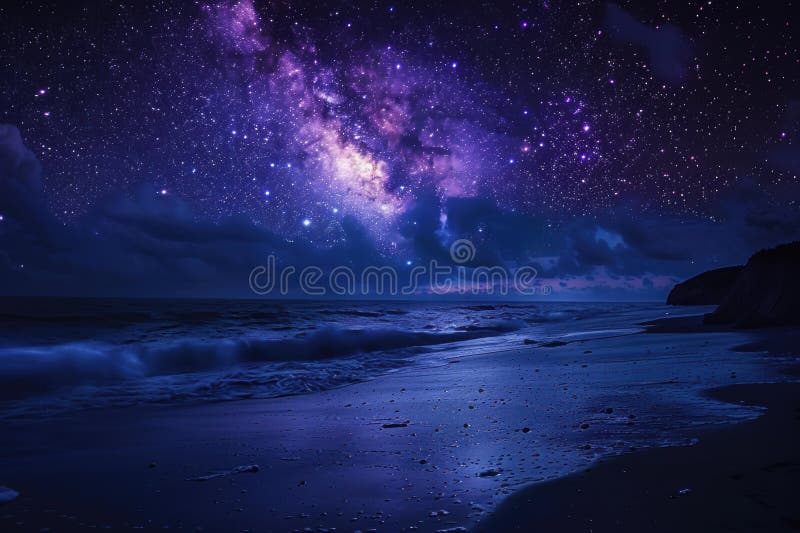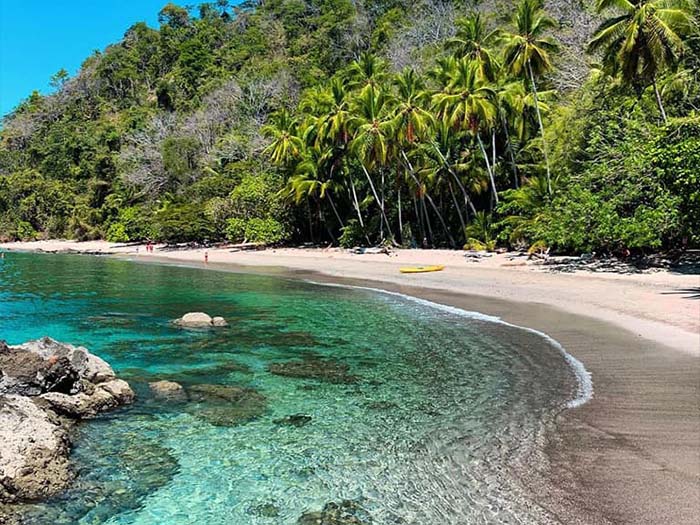Chasing Starlight: Bioluminescent Wonders and Dark Sky Escapes for the Eco-Conscious Traveler

Imagine standing on a beach, the sand soft beneath your feet, the air alive with the scent of salt and something else...magic. Above, the cosmos unfolds in a breathtaking tapestry of stars, and below, the water shimmers with an otherworldly glow. This is the allure of dark sky tourism and bioluminescence travel, a growing trend among millennial and Gen Z travelers seeking transformative experiences rooted in sustainability and awe. These natural phenomena offer a profound connection to our planet and a much-needed escape from the stresses of modern life. We'll explore three unique bioluminescent destinations: Vaadhoo Island in the Maldives, Mosquito Bay in Puerto Rico, and Torrey Pines State Beach in California. Prepare to be inspired, rejuvenated, and reminded of the cognitive benefits that await when we embrace the darkness and the wonders it reveals. (Interested in more travel advice? Check out our guides on sustainable travel!)
Experiencing awe-inspiring natural wonders like these isn't just visually stunning; it's also good for your mental wellbeing. Studies have shown that exposure to nature can reduce stress, improve cognitive function, and boost creativity. According to research published in the Journal of Environmental Psychology, spending time in natural environments lowers cortisol levels (a stress hormone) and enhances attention span. Immersing ourselves in the darkness and witnessing the magic of bioluminescence allows us to tap into these benefits, fostering a sense of wonder and connection that can transform our perspective.
Vaadhoo Island, Maldives – The Sea of Stars
Step onto the shores of Vaadhoo Island, and you'll find yourself transported to another world. Here, the ocean transforms into a breathtaking "Sea of Stars," thanks to the presence of bioluminescent dinoflagellates, specifically Dinoflagellate phytoplankton. As waves gently lap against the shore, these tiny organisms emit an intense blue glow, creating a surreal mirror image of the night sky above. The soundscape is pure tranquility: the soft lapping of waves, the quiet hush of the island breeze rustling through palm trees. The warm, humid air embraces you as you walk barefoot on the soft sand, each step igniting a fresh burst of light. This is Vaadhoo Island bioluminescence tour experience, unforgettable and truly transformative.
The magic behind this spectacle lies in a simple chemical reaction. These dinoflagellates contain luciferin, a light-emitting molecule, and luciferase, an enzyme that catalyzes the reaction. When disturbed by the movement of the waves or your footsteps, these organisms trigger the reaction, resulting in the mesmerizing blue glow.
Capturing the Cosmos: Astrophotography Tips for Vaadhoo
Want to capture this ethereal beauty? Here's an astrophotography travel destinations tip:
- Tripod is Key: A sturdy tripod is essential for long-exposure shots.
- Wide-Angle Lens: Use a wide-angle lens (14mm-24mm) to capture both the bioluminescence and the Milky Way.
- Low Aperture: Set a low aperture (f/2.8 or lower) to allow as much light as possible to reach your camera sensor.
- Composite Image: Consider creating a composite image by blending a shot focused on the bioluminescent shoreline with another focused on the Milky Way for optimal results.
Responsible Travel in the Maldives
It's vital to approach Vaadhoo Island with respect and a commitment to sustainable travel. Follow these guidelines to help:
- Minimize Your Impact: Avoid disturbing the natural environment. Stick to designated pathways and avoid stepping on coral or disturbing marine life.
- Say No to Single-Use Plastics: Bring your own reusable water bottle, shopping bags, and containers to minimize plastic waste.
- Support Eco-Friendly Resorts: Choose accommodations that prioritize sustainability and environmental responsibility. Many resorts on Vaadhoo Island are committed to reducing their carbon footprint and protecting the surrounding ecosystem. Look for resorts with sustainable travel certifications.
- Ethical tourism practices for bioluminescent ecosystems: Only use reef-safe sunscreen to avoid damaging the fragile marine ecosystem.
Mosquito Bay, Vieques, Puerto Rico – A Bioluminescent Paradise Recovered
Imagine gliding through calm waters in a kayak, surrounded by an emerald green glow so intense it feels like you're paddling through liquid light. This is the experience that awaits you in Mosquito Bay on Vieques, Puerto Rico, considered one of the brightest bioluminescent destinations in the world. The heavy, humid smell of the mangroves hangs in the air, carried by a humid breeze, as nocturnal wildlife calls out in the distance. Touching the water creates a swirling vortex of light, a mesmerizing dance of nature that will leave you breathless.

Mosquito Bay's exceptional bioluminescence is due to a unique combination of factors. The bay is a shallow, enclosed body of water surrounded by mangrove forests. These mangroves provide nutrients and shelter for the bioluminescent dinoflagellates, fostering an incredibly high concentration of these organisms. The narrow channel connecting the bay to the open ocean helps to trap the dinoflagellates, further enhancing their density.
Protecting a Natural Treasure
Mosquito Bay has faced challenges from light pollution and environmental degradation in the past. However, concerted efforts have been made to protect this precious ecosystem. To minimize light pollution, the surrounding area has implemented strict regulations on outdoor lighting. Initiatives are also in place to educate visitors about the importance of responsible tourism.
Responsible Tourism in Mosquito Bay
When visiting Mosquito Bay, it's crucial to prioritize the preservation of this fragile ecosystem. Here's how you can embrace responsible travel bioluminescence:
- Choose Authorized Tour Operators: Only use authorized tour operators who follow strict environmental guidelines. These operators are trained to minimize their impact on the bay and ensure the safety of the ecosystem.
- No Swimming: Avoid swimming in the bay to prevent disturbing the delicate balance of the ecosystem. Human contact can introduce pollutants and damage the dinoflagellates.
- Respect the Environment: Refrain from touching or disturbing the mangroves or any other marine life. Pack out all trash and leave no trace of your visit.
- Cognitive benefits of seeing the stars: Take in the serene darkness for improved mental wellbeing.
- Eco-friendly tours bioluminescent bays: Ensure your chosen operator adheres to strict environmental guidelines.
Capturing the Moment
While astrophotography can be challenging in Mosquito Bay due to its brightness, capturing the bioluminescence itself is very feasible. Use a high ISO setting and a fast lens to get the best shots.
Torrey Pines State Beach, California – Urban Stargazing and Coastal Darkness
Escape the urban sprawl of San Diego and discover a surprising haven for stargazing at Torrey Pines State Beach. Perched atop dramatic cliffs overlooking the Pacific Ocean, this coastal gem offers a unique opportunity to witness the stars despite its proximity to the city. While the urban glow is visible on the horizon, the relative darkness above provides a window into the cosmos. The sound of crashing waves echoes below, creating a soothing soundtrack for your celestial observations. Imagine a time-lapse video capturing the movement of the stars above the iconic cliffs, a testament to the enduring beauty of the night sky. Torrey Pines offers Torrey Pines dark sky hiking and exceptional views.

Torrey Pines benefits from its coastal location and the efforts of local astronomy enthusiasts who advocate for dark sky preservation. While not a designated Dark Sky Park, Torrey Pines offers surprisingly good stargazing opportunities, especially during meteor showers like the Perseids. The cool, salty air invigorates your senses as you stand on the rugged cliffs, gazing at the celestial wonders above.
Responsible Astrotourism at Torrey Pines
Even in an urban environment, we can minimize our impact on the night sky. Embrace responsible astrotourism by following these guidelines:
- Red Light Flashlights: Use red light flashlights to minimize light pollution and preserve your night vision. Red light has a minimal impact on the visibility of stars.
- Pack Out All Trash: Leave no trace of your visit. Pack out all trash and dispose of it properly.
- Respect Wildlife: Be mindful of nocturnal wildlife and avoid disturbing their habitat.
- Dark sky hiking trails Torrey Pines State Beach: Explore the trails at night with a red light flashlight for better visibility and lower impact.
Nearby Dark Sky Initiatives
While Torrey Pines itself isn't a designated Dark Sky Park, the San Diego region is home to growing efforts to protect the night sky. Organizations like the San Diego Astronomy Association are working to raise awareness about light pollution and promote responsible lighting practices.
Conclusion: Embrace the Darkness, Protect the Light
From the shimmering shores of Vaadhoo Island to the emerald glow of Mosquito Bay and the coastal stargazing of Torrey Pines, these destinations offer unique opportunities to connect with the natural world and experience the transformative power of darkness. By embracing sustainable stargazing tours and responsible travel practices, we can help protect these fragile ecosystems and ensure that future generations can marvel at the wonders of bioluminescence and the beauty of the night sky.
Support the International Dark-Sky Association (IDA) (https://www.darksky.org/) and other organizations dedicated to dark sky preservation and responsible tourism. Share your own dark sky experiences on social media using #VistaLocationStargazing and inspire others to embrace the darkness and protect the light. Bioluminescence travel can be an incredible, educational experience - get out there and explore!